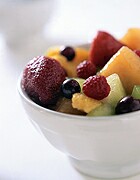
TUESDAY, Dec. 16, 2014 (HealthDay News) — Poor students get more fruits and vegetables at school than they do at home, a new study finds.
But, the opposite is true for students from wealthier families.
These findings show that having fruits and vegetables at school may give a healthy boost to poor students’ diets, according to the study.
But, no matter what the family income level, students all ate a similar amount of fruits and vegetables at school, the study found.
The study was published recently in the journal Preventive Medicine.
The researchers compared fruit and vegetable consumption among nearly 1,900 middle school students in New Hampshire and Vermont during the school year and summer vacation.
“This study confirms that the national and regional school food programs provide an important source of fruits and vegetables for low-income adolescents, which we know is a key indicator of dietary quality,” study author Madeline Dalton from Dartmouth-Hitchcock Medical Center said in a university news release.
“Schools clearly have a role in providing healthy foods to children. Our data suggest that the most vulnerable students are benefiting the most from school food,” study co-author Meghan Longacre, from Dartmouth-Hitchcock Medical Center, said in the news release.
“Innovation in school food offerings for kids has emphasized increased consumption of fruits and vegetables and it’s working for low-income kids, but the evidence shows that a different strategy may be needed to have the same positive effect on high-income kids,” Longacre said.
More information
The U.S. National Library of Medicine has more about child nutrition.
Copyright © 2025 HealthDay. All rights reserved.

